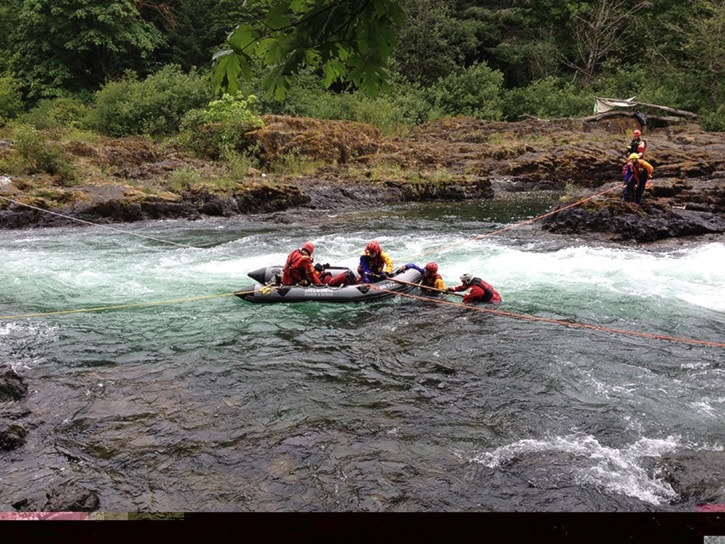THEY’RE there every year, at the back end of the annual Riverboat Days parade with vehicles and equipment along with other local emergency services.
But this past August long weekend, not many people would have known that members of Terrace Search and Rescue who were in the parade, on the water for the fire works and on the water for the Rotary Duck race as well, were also in the middle of one of their busiest and most challenging periods of the past several years.
Dave Jephson, a key and long serving member of Terrace Search and Rescue, reels off a list of call outs.
There was a recovery the Friday of the long weekend of a person killed in an industrial accident west of Terrace, a recovery in the middle of July of a pilot killed near Dease Lake when his plane crashed into a mountainside, and the search over the long weekend for a man who drowned in a lake south of Vanderhoof.
“We have a one-call system,” says Jephson. “What I do is send out one call and within minutes, it reaches 56 people.”
“Then it’s a matter of who responds and we then work out each team members training and capabilities depending upon what we need.”
Those assistance requests, Jephson adds, are examples of the geographic reach of Terrace Search and Rescue and of how its capabilities and activities extend beyond the definitions of those words in the name of the organization.
Over the years Terrace Search and Rescue has developed expertise in diving, swift water rescue, ice rescue and difficult terrain rescue and recovery.
When called by the RCMP the group receives a task number making it part of the grouping of emergency services gathered for the job at hand.
“That’s when we come under the [official] umbrella,” noted Jephson.
That helps cover expenses and provides for insurance for team members and assistance for equipment replacement.
One of the recent examples was a small team of long rope experts within Terrace Search and Rescue called in by the RCMP to assist with the recovery of a pilot from a Tsayta Aviation Services Beaver float plane killed near Dease Lake when his aircraft flew into a mountain.
Four team members first flew from Terrace to Telegraph Creek where they were met by a helicopter and a RCMP officer and then flown to the crash site and then lowered down to recover the body and bring it back, said Jephson.
The drowning recovery south of Vanderhoof at Arthur Lake began for Terrace Search and Rescue with a 7 a.m. phone call July 31, the Sunday of the August long weekend.
“This was after we had been at the fireworks until 3 a.m.,” said Jephson of having a boat on the Skeena River as a safety precaution during the late night display.
In Vanderhoof, two men the evening before, not wearing lifejackets, somehow ended up out of their boat on Arthur Lake and in the water.
“One, a 26-year-old, was having difficulty and his partner would dive under him to hold him up,” said Jephson.
But when that partner turned to grab the boat which was circling the pair with engine still running, and then turned back, the other was gone.
“Can you help with sonar,” said Jephson of the call received from Vanderhoof.
That resulted in three team members making the long drive to Vanderhoof beginning at 9:20 a.m. that Sunday morning and then south to the lake where they set off in a locally-provided freighter canoe to begin a grid pattern search of Arthur Lake using a sophisticated sonar device.
Not finding anything despite searching late into the evening, the Terrace team returned home, arriving back in the very early morning of hours of Monday, Aug. 1, B.C. Day.
Another team then set out that afternoon and was on the water by 7 a.m. the following morning, Tuesday, Aug. 2.
“That just shows you the determination and the good people we have,” said Jephson of the journeys made by the two Terrace teams.
The second team searched all day Aug. 2 until night fell, stayed in the area, and resumed the morning of Aug. 3 by dropping the sonar into the water in the hopes of finding images of the missing angler.
A RCMP dive team found the angler later in the morning of Aug. 3.
“And that’s fine. We’re not there for the glory. The closure is when he’s with his family. That’s why we do this,” Jephson said.
The same principle is in play when the team takes part in searches that aren’t official ones.
Although the drop down sonar is effective by rotating 360 degrees in the water on a grid pattern to provide images for further examination, Terrace Search and Rescue now has its eye on a sonar tow fish variety.
It can be used in much deeper water than the current one and provides searchers with a wider search pattern using side scan technology.
Jephson describes it as a complement to a newly-purchased remote operating vehicle which can descend as deep as the towfish, 1,000 feet, and has a light and a camera and a gripper to retrieve objects.
“We could just cover more area,” he said. It costs upwards of $50,000, depending upon the model chosen, and Terrace Search and Rescue has begun raising money for its purchase.
